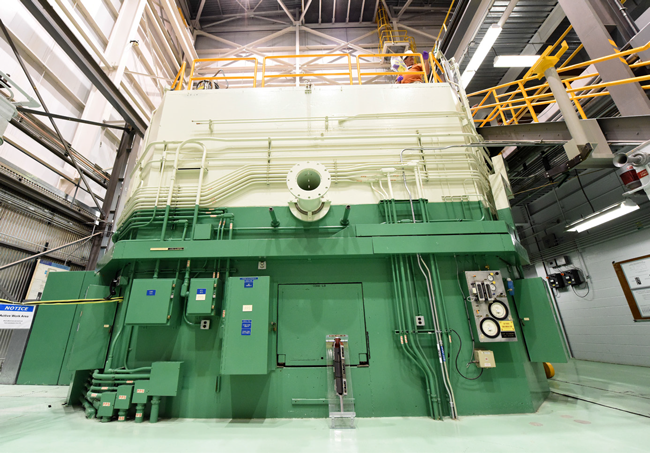
The Transient Reactor Test (TREAT) Facility at Idaho National Laboratory is a national asset that provides unique test results in an essential nuclear research field. It will foster the development of new ways to provide baseload and load following electrical power. Transient testing is an essential component of the United States and international efforts to develop robust, safer nuclear fuels, and to bring innovative reactor technologies to the market.
Transient testing involves the application of controlled, short-term bursts of intense neutron flux directed toward a test specimen in order to study fuel and material performance under off-normal operational conditions and hypothetical accident scenarios. After the transient test, the fuel or material is analyzed at a post-irradiation examination (PIE) facility. The results of these examinations are then evaluated and used in advancing fuel or material design and qualification.
TREAT is a highly capable test reactor. Detailed real-time monitoring of the specimens during a test is possible via the hodoscope, a system that detects fast neutron signatures from experiments, and other experiment and core instrumentation. This instrumentation, coupled with PIE, allows scientists to determine the appropriate safety limits for the fuels and materials in nuclear power reactors. TREAT's simple, self-limiting, air-cooled design can safely accommodate multipin test assemblies, enabling the study of fuel melting, metal-liquid reactions, overheated fuel and coolant reactions, and transient behavior of fuels for high temperature system applications.
The TREAT facility operated from 1959 through 1994, when it was placed in standby mode. A resurgence of interest in developing innovative nuclear technologies has driven demand for transient testing. TREAT was restarted in 2017 and is currently supporting experiment programs.
TREAT provides transient testing of nuclear fuels and materials. The facility is used to study fuel melting behavior, interactions between fuel and coolant, and the potential for propagation of failure to adjacent fuel pins under conditions ranging from mild upsets to severe accidents.
TREAT is an air-cooled, thermal-spectrum test facility specifically designed to evaluate the response of reactor fuels and structural materials to accident conditions. The reactor was originally constructed to test fast-reactor fuels, but its flexible design has also enabled its use for testing of light-water-reactor fuels as well as other exotic special-purpose fuels, such as space reactors. TREAT has an open-core design that allows for ease of experiment instrumentation and real-time imaging of fuel motion during irradiation, which also makes TREAT an ideal platform for understanding the irradiation response of materials and fuels on a fundamental level.
TREAT was was placed on standby in 1994. TREAT was restarted in 2017 and is currently supporting experiment programs. TREAT provides a valuable capability to support efforts to develop accident-tolerant fuels for light-water reactors as well as the advanced reactor fuels, both of which will allow nuclear power to remain the primary source of emission-free baseload energy in the future.
Basic Capabilities: